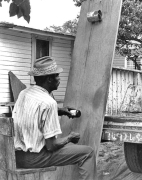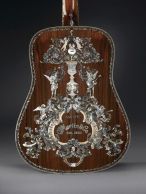Finally . . I’m getting around to writing the third, and final, installment of ESS-ential (Expression, Strength, and Simplicity) Guitar Building. Expression and strength were the subjects of my previous two entries. Today I want to address simplicity.
The basics of guitar design are not all that complicated. Strings under tension vibrate and resonate through a box, producing sound. The builder can accomplish this with relative ease using on ly materials at hand and creative thought. Diddley bows are constructed with simple boards, wire, and cans. Cigar box guitars are exactly what the name implies, guitars made from cigar boxes. These crude and inexpensive instruments, in the hands of even a mediocre player, produce raw, basic, and extremely pleasin
ly materials at hand and creative thought. Diddley bows are constructed with simple boards, wire, and cans. Cigar box guitars are exactly what the name implies, guitars made from cigar boxes. These crude and inexpensive instruments, in the hands of even a mediocre player, produce raw, basic, and extremely pleasin g music. On the other hand, there are guitars so finely engineered, expertly crafted, and extravagantly adorned that they cost many thousands of dollars. These are made in high end factories (the guitar at the right is the one millionth guitar Martin produced), or in the shops of custom builders. These, then, are the extremes: very simple on one hand and bafflingly complex on the other. The challenge for builders, like myself, is reigning in the desire for the complex so that the simple can be learned, practiced, and employed.
g music. On the other hand, there are guitars so finely engineered, expertly crafted, and extravagantly adorned that they cost many thousands of dollars. These are made in high end factories (the guitar at the right is the one millionth guitar Martin produced), or in the shops of custom builders. These, then, are the extremes: very simple on one hand and bafflingly complex on the other. The challenge for builders, like myself, is reigning in the desire for the complex so that the simple can be learned, practiced, and employed.
One must learn to intentionally move from the ‘complexity of possibility’ into the ‘practice of now’ and then on to the ‘complexity of refinement.’ In other words: from the complex to the simple and back to the complex again. Let’s examine these one by one.
I confess that I have a problem with the ‘complexity of possibility.’ I think so many things are cool that I have difficulty focusing on just one and actually getting it on my workbench. Currently I have eleven specific guitars that I plan on building or restoring. Six acoustics, three electrics, and two cigar box guitars. Each one has consumed more dream/fantasy time than I care to admit. Many times Ramona, my wife, will come out to the garage and find me just sitting in a chair. “I thought you were out here building,” she’ll say. My reply is always the same: “I am, I’m just thinking.” Thinking and doing are critical components of building a guitar. Each deserves, and requires, proper attention. But at some point painful choices must be made, full well knowing that each decision necessarily excludes hundreds of other possibilities. And some of those may never come to pass. But when you know what you want to do then the ‘practice of now’ begins.
This second stop on the creative journey is the simple stage (from the complex to the simple and back to the complex again, remember?). But simple isn’t easy. Practicing ‘now’ is an orderly progression. Nothing is random. You refine the design (always knowing that it will change), select the wood, collect the materials and tools, execute the skills, solve the problems, fix the mistakes, and sand (lots of sanding!). It’s critical to remember that practicing the ‘now’ requires immediate, focused attention. You cannot think too far ahead and you must always work within your capabilities. If you’re not satisfied with your present skill set then you have to put off learning and practicing that skill for another time, when you can concentrate on it solely. But, all told, at this point you have a playable instrument. You can leave it as is or . . . move on to the next stage, the ‘complexity of refinement.’
Adorning a guitar is a complex issue requiring intricate inlay and carving skills, knowledge of materials (mother of pearl, abalone, etc.), and artistic flair. In my opinion, this level of complexity can get way out of hand. Take another look at the photograph of the one millionth Martin guitar. It’s beautiful to look at but I wonder how it sounds and plays. I’ll never know. Only a few people have ever held or played it. Because of its fragile decorations it lives in a perfectly maintained, humidified, and lighted case in the museum at the Martin factory. Look, but don’t touch. I know so many players who own such ornate guitars that they’re afraid to get them out of the case, fearing scratches or smudges. To me, this belies the purpose and nature of a guitar – to bring harmonic resonance into the universe. A guitar should have a functioning balance between form and beauty. As a builder, I try to remember that this stage of the process, the ‘complexity of refinement,’ is made possible only upon the successful achievement of the first two steps, ‘complexity of possibility’ and the ‘practice of now.’
My guitars are what I call approachable. I’m very comfortable in touching and playing them, and I’m not afraid to allow others to do the same. And I think they look pretty darn good, as well. From the complex to the simple and back again to the complex. It’s mystical!

I truly can see what you’re saying. I would humbly propose the use of haustaful…dictum oiconomia…parsimonious connectivity…KISS. As Oley would say, “Your ‘simple’ is pretty damn complicated.”
LikeLike